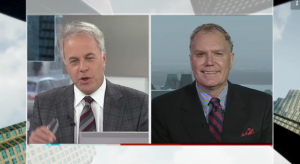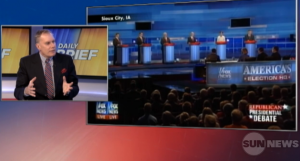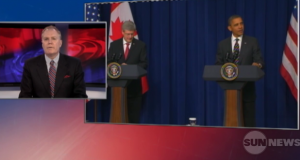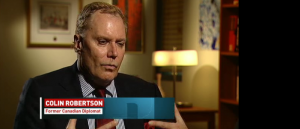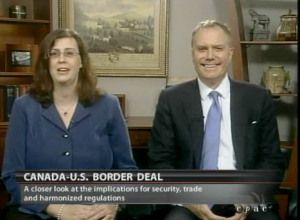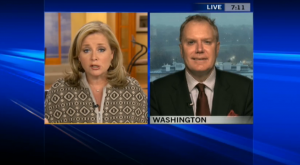- January 4, 2012 Powerplay’s Don Martin interviews Scotty Greenwood and Colin Robertson. Scotty Greenwood with McKenna Long & Aldridge LLP
says Iowa was important because it was first and it gives candidates momentum with fundraising and media. Former diplomat Colin Robertson says Canada should care about the GOP race because it could greatly affect U.S. relations. 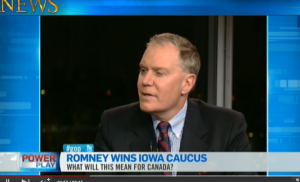
Iowa, Romney, Santorum and Paul and XL Pipeline
Iowa caucuses matters to Canada
With the Iowa caucuses underway, Colin Robertson talks about what the race south of the border means to Canada with SUN-TV’s Daniel Proussalides, January 3, 2012
Why the Iowa caucuses and primaries matter to Canada
From ipolitics.ca January 2, 2012 What the caucuses and primaries have to do with Canada
Canadians often think that we know all about America, while Americans think that they know all they need to know about us. As U.S. Ambassador David Jacobson has observed, we are both wrong.
Ties of history, culture and geographic propinquity, which facilitate trade and investment, mean that the U.S. will always be primordial to Canadian interests. We always have an agenda with the United States and because of the asymmetries in our relative interests and global positioning, the responsibility for initiative and action lies with us.
When we get it right we advance not only our own interests, but we gain additional leverage from our ability to explain America to the rest of the world and, when we properly manage our international diplomatic network, the rest of the world to America.
The 2012 American election has already provided both entertainment and an education in the politics of our southern neighbour.
The occupant of the Oval Office is still the most powerful leader in the world and the person who will take the oath in January 2013 matters to Canada. We need to know all about that person and their administration.
The issue matrix is different depending on who controls the agenda. Democrats tend to be more protectionist and emphasize environmental issues (e.g., Waxman-Markey would have potentially assessed a surcharge on oil sands products) while the Republicans put a higher priority on security, (e.g., Western Hemisphere Travel Initiative which obliges a passport or a ‘smart’ driver’s licence for cross-border travel.)
In the 2008 primaries, both major Democratic candidates, Hillary Clinton and Barack Obama, promised to renegotiate NAFTA because of labour and environmental concerns. The subsequent leak of a Canadian diplomatic dispatch reporting that Obama campaign adviser Austan Goolsbee suggested this was mere electioneering on the part of candidate Obama caused considerable embarrassment. Goolsbee later became chair of President Obama’s Economic Advisory Council,
Deepening economic integration, including the new border initiative and ongoing regulatory reform means that more and more of the decisions that count take place at the state level, underlining the need for a Canadian 50 state strategy to complement our congressional outreach. Most of our trade disputes (e.g., lumber, beef) originated at the local level or have a local dimension (e.g., the XL pipeline and the original route through the Nebraska Sandhills) before they developed into issues on Capitol Hill.
Another example of how a local interest can stymie a bilateral issue is the long-planned second crossing between Detroit and Windsor. The business owner of the Ambassador Bridge has blocked approval of the second crossing in the Michigan state legislature, notwithstanding the strong support of Governor Rick Snyder and the continuing efforts of Ontario and federal government authorities who have offered to fund Michigan’s $550-million share of the new bridge (with the money to be paid back through subsequent tolls). The thousands of trucks that cross the Ambassador Bridge each day carry about 25 percent of the annual merchandise trade between Canada and the United States.
The success of the new border initiative will require the collaborative efforts of the federal, state and province and municipal authorities on both sides of the border. The bailout and restructuring of Chrysler and General Motors, making possible the subsequent recovery of our auto industry, is a good example of tri-level and cross-border collaboration on the auto trade that dates back to the 1965 Autopact.
In pursuit of Canadian interests in the U.S., the presidency is our main entry point into the American system, itself a spaghetti bowl of competing interests and factions.
These include the members of Congress and their staff, the administration and its agencies, the lobbyists (there are now more than 33,000 in Washington), the lawyers, the think-tanks, the media and the other special interests that are constantly shifting, aligning and realigning on and around Capitol Hill. The internet and the rise of YouTube, blogs, and tweets have further “democratized” and “atomized” the political process.
The American political process has become polarized and even more partisan. “It’s not just a tug of war between left and right”, writes New York Times columnist Charles Blow, “It’s a struggle between the mind and the heart, between evidence and emotions, between reason and anger, between what we know and what we believe.” American politics, observes the National Journal’s Ron Brownstein “increasingly resembles a kind of total war in which each party mobilizes every conceivable asset at its disposal against the other. Most Governors were once conscientious objectors in that struggle. No more.” Or Newt Gingrich told ABC News on the weekend before the Iowa caucuses, “”Politics has become a really nasty, vicious, negative business and I think it’s disgusting and I think it’s dishonest.”
Within this fractious and often confusing context, a foreign power is just another special interest and, without the tools of money or votes, not particularly special. Working this system has become even more complicated because of the continuing dispersal of power in the U.S. and the legions of special interests armed with cheque books.
It makes it more difficult to build the necessary coalitions of cross-party support that we usually require to either prevent passage of legislation contrary to our interests or support for an initiative. But it starts with an appreciation of the American system. The excitement and passion of this latest exercise in their democratic process provides an ideal daily education to learn and understand better the country that continues to matter the most to Canadians.
This column draws from the CDFAI’s “A Canadian Primer to the 2012 U.S. Primaries and Caucuses”.
A Canadian Primer to the 2012 US Primaries and Caucuses
Contents page from A Canadian Primer to the 2012 US Primaries and Caucuses published by the Canadian Defence and Foreign Affairs Institute
Introduction
Who’s running for the Republicans and what are their platforms?
Where do they stand?
What’s the difference between a primary and a caucus?
Is the process starting earlier than usual?
Are the Iowa caucuses (January 3) important?
What about the Iowa Straw Poll held last August?
And the New Hampshire primary (January 10)?
Do the parties do their primary process differently?
Haven’t there been a lot more candidate debates?
Do the debates matter?
Are all of the Republican presidential candidates on every ballot?
Are the primaries just for presidential nominees?
How are delegates apportioned?
Does the primary winner ‘take all’?
Does President Obama have to go through the primary process?
When are the conventions?
What are the chances of a convention fight?
What about a third party candidate?
What about Senate and House races?
And elections for Governor?
Do incumbents have an advantage?
How much does this all cost?
What is the mood of America?
Has Canada been a factor in the Republican race?
Why does this matter to Canada?
Want to know more?
2012 Election Calendar
See columnist Barry Cooper’s ‘In U.S. politics, ideas come second to money’ in Calgary Herald, January 11 2012
The various bits of spaghetti include elected officials and bureaucrats, lobbyists and think-tanks, mainstream media, along with bloggers and tweeters, party organizations and factions within them, all operating in an atmosphere of partisan intensity. As Newt Gingrich told ABC News, politics in America “has become a really nasty, vicious, negative business and I think it’s disgusting.”…
Detroit River Crossing
Excerpted from The Windsor Star ‘New Bridge Need grows stronger’ December 31, 2011
The new Windsor-Detroit bridge may still be waiting for final legislative approval in Michigan, but one thing is certain – the case for building the downriver crossing is rock solid. The economies of Ontario and Michigan and Canada and the U.S. need the bridge to sustain hundreds of thousands of jobs and create new ones.
Over the past year, Michigan Gov. Rick Snyder has continued to champion the project and, despite the politicking of a handful of Michigan lawmakers, has vowed to get the bridge built.
The sense is that Snyder will move to push the project forward in the new year, and he will do so with the full support of President Barack Obama, Prime Minister Stephen Harper, Ontario Premier Dalton McGuinty and virtually everyone in the Canada-U.S. business community who understands that our essential trading relationship can no longer be held hostage by a few individuals.
As we approach the start of 2012, it’s a good time to refocus on the need for an updated and efficient border to ensure future growth on both sides of the border.
First, this isn’t just a Windsor-Detroit issue. We are at the heart of the Great Lakes-St. Lawrence region which represents the fourth largest economy in the world – $4.6 trillion in economic output in 2009. More than $2 billion in good and services goes back and forth across the border every day, including $356 million through Windsor-Detroit.
Second, consider the numbers that have been used to support a new publicly owned downriver bridge:
. Bilateral trade supports more than eight million U.S. jobs, including 220,000 in Michigan. One of three Canadian jobs rely on U.S.-Canada trade.
. Canada is Michigan’s largest trading partner, purchasing 58 per cent of all Michigan’s foreign-bound goods. In 2008, trade between Canada and Michigan reached $67.4 billion.
. Annual trade between Canada and the U.S. is more than $500 billion a year and one-quarter of that trade relies on the Windsor-Detroit crossing.
. Commercial truck traffic is expected to increase more than 100 per cent by 2035.
All of those figures add up to the need for a modern, publicly owned bridge on the Detroit River. And the case for the new bridge was eloquently argued last summer by former Michigan Gov. James Blanchard and Colin Robertson, a former Canadian diplomat and senior strategic adviser with McKenna Long & Aldridge LLP
“The 105 million people living in the (Great Lakes-St. Lawrence) region today need their respective governments to continue to work together on the border. To remain the world’s fourth largest economy, the region needs a second Detroit-Windsor crossing.
“Our most integrated trade industry by far, the production and assembly of automobiles is concentrated in the Great Lakes region. This ‘industry of industries’ draws in hundreds of feeder manufacturers in dozens of locations in Canada, the United States and Mexico.
“But the top priority has to be the construction of a second bridge between Windsor and Detroit. In the 7,000 trucks that daily cross the Ambassador Bridge are contained over a quarter of the goods traded between Canada and the U.S. Any interruption in traffic on this 80-year-old, privately owned bridge means layoffs: thousands in the first day and tens of thousands stretching south to the Carolinas by day two. Resiliency, national security and the national interest of both countries requires us to build a second crossing, the new International Trade Crossing.”
As we usher in the new year, it’s time to get the shovels in the ground.
Read more: http://www.windsorstar.com/news/bridge/5931698/story.html#ixzz1iOplJvBr
Beyond the Border Deal
Border Deal
Neil Macdonald interviews Colin Robertson on the border accord for CBC’s The National

